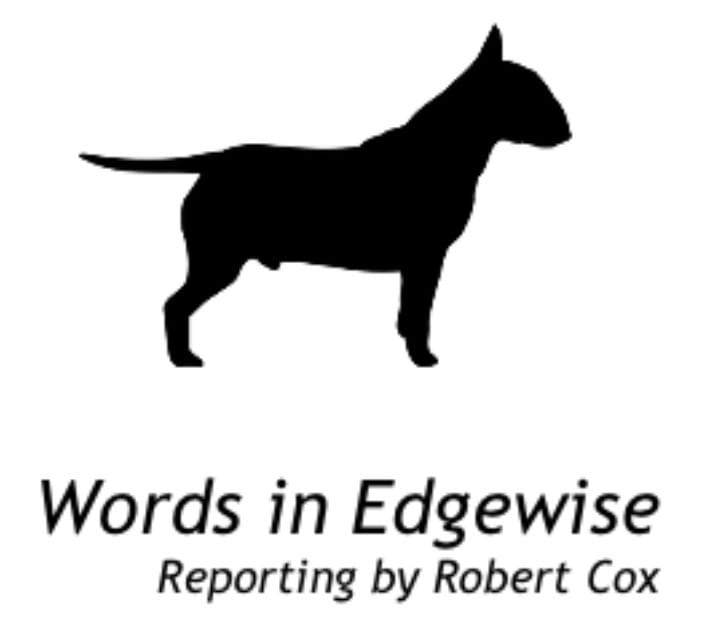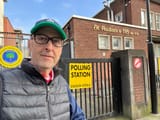How Does Sustainable Westchester Get All That Good Green Power to My Home?

There are no tiny green electrons flowing through the wires connecting a waterfall to a magic lamp.
DUBLIN, IRELAND (May 23, 2024) — Many readers have wondered: just how is Sustainable Westchester getting all that green energy goodness from the pristine wilderness of upstate New York to my house each day to light up a lamp in my living room?
The short answer?
They ain’t.
This article is for all the hucksters out there selling the fantasy that Sustainable Westchester is running extension cords from a waterfall-propelled turbine in upstate New York to deliver all that green goodness to the wall sockets in all those cozy living rooms throughout Westchester County.
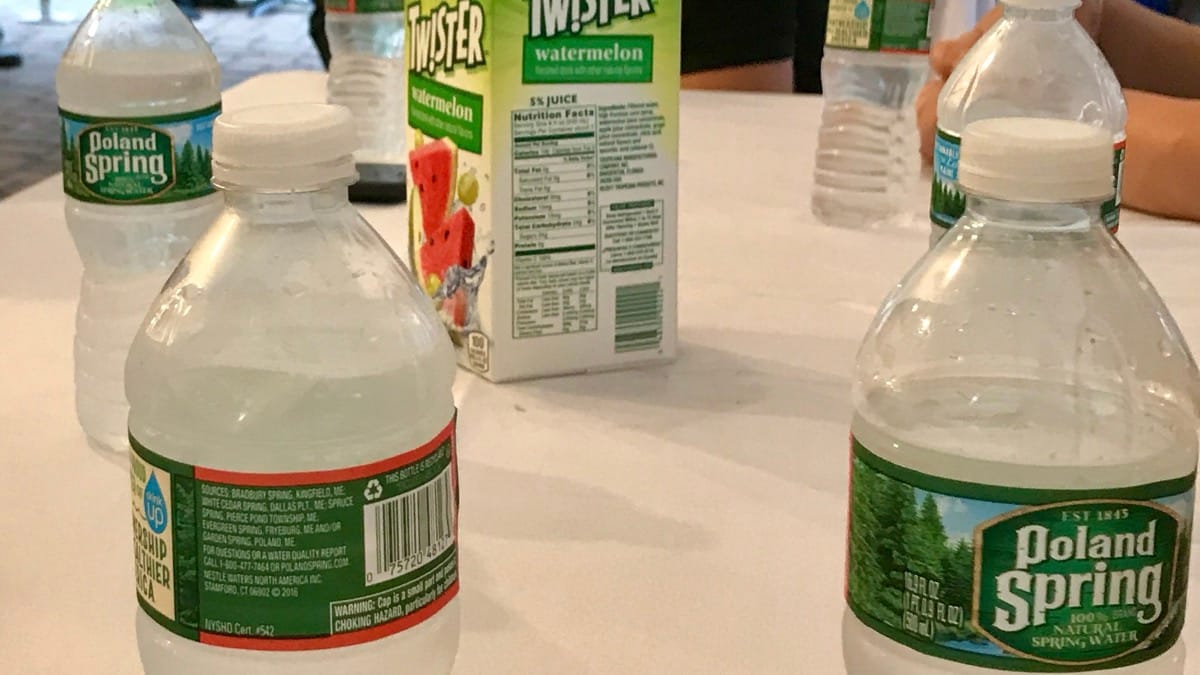
For the suckers buying what the hucksters are selling, think of it more like Poland Spring bottled water: regular old groundwater extracted in Maine then poured into a plastic container at a bottling facility where a machine slaps a label with an image of a river running through a forest on the side.
Hate to be the one to tell you but there are no magic green electrons flowing through the wires connecting the utility pole outside to your home.
All that electricity is regular old bad electricity from Con Edison or NYSEG, depending on where you reside in Westchester.
It is no mystery how that electricity is generated, all utilities are required to report their fuel mix annually.
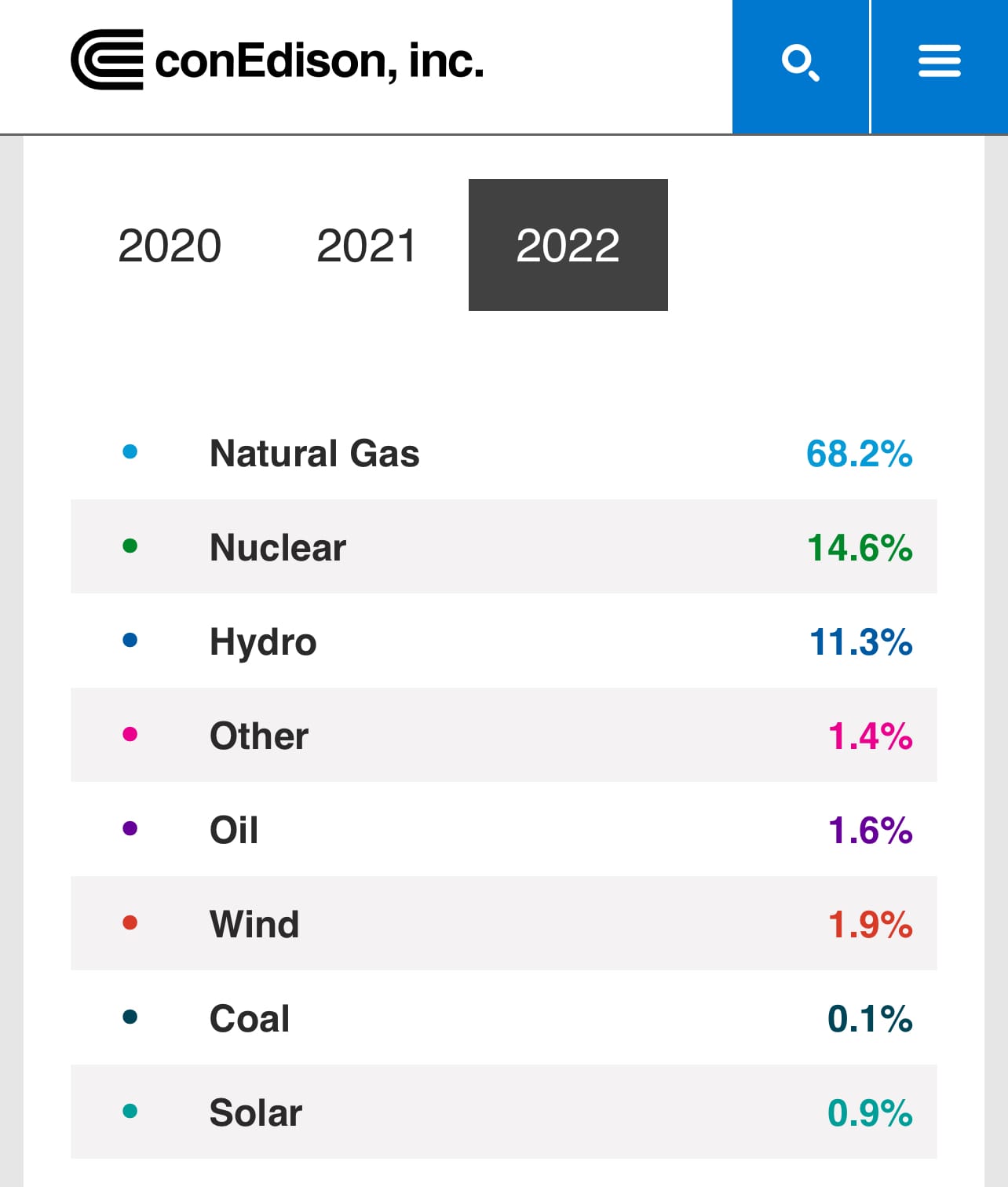
For example, in 2022, the last full year when data is available, Con Edison reported that its Fuel Mix was 83% Natural Gas and Nuclear. That is the source of electricity going into Westchester homes from both Con Edison-owned generation and their purchase of electricity off the grid from sources all over North America.
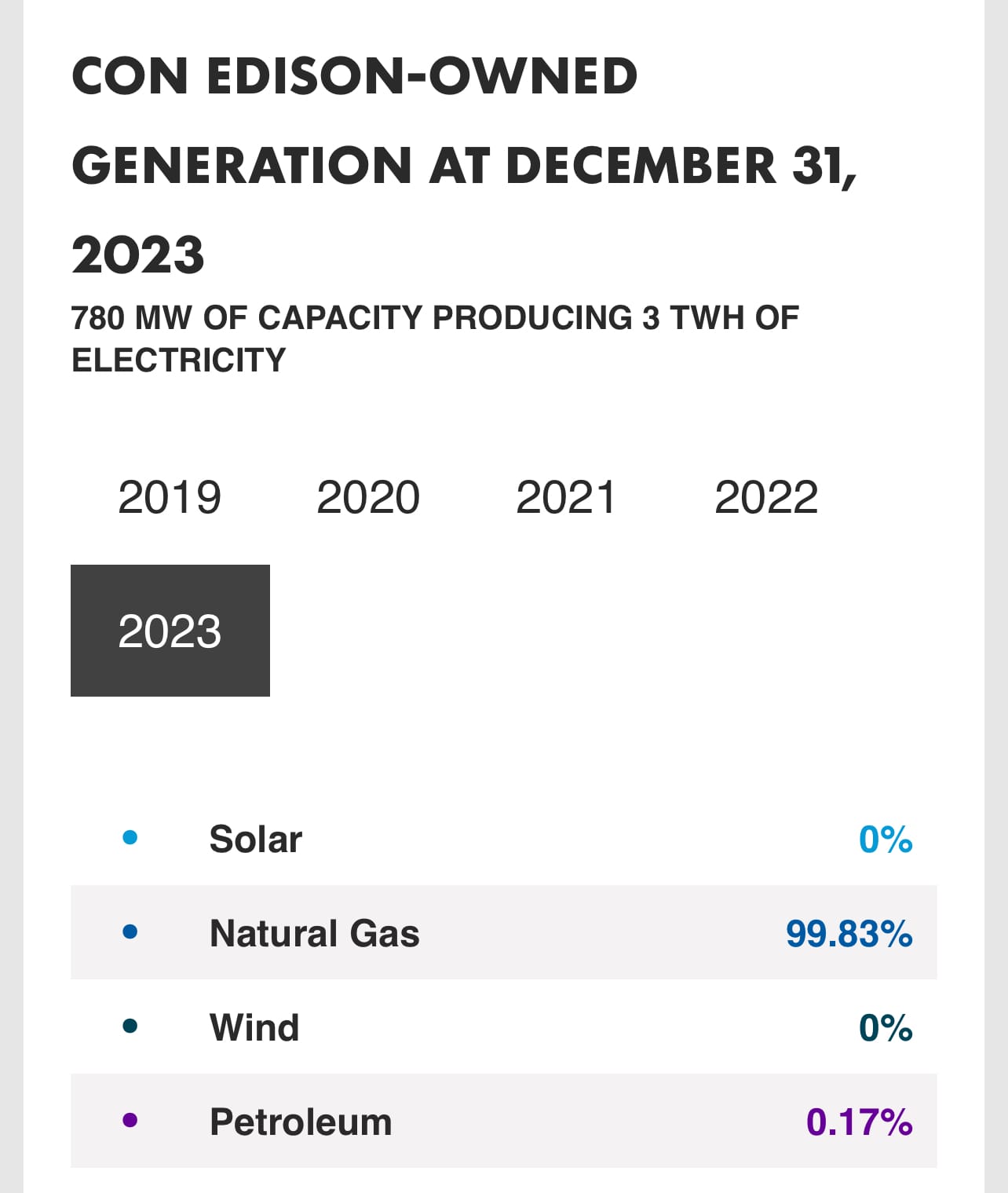
For 2023, the last full year when data is available, Con Edison reported that its Fuel Mix for power it generated on its own was 99.83% Natural Gas.
It is why Sustainable Westchester explains price movements in electrical prices as correlated to Natural Gas prices.
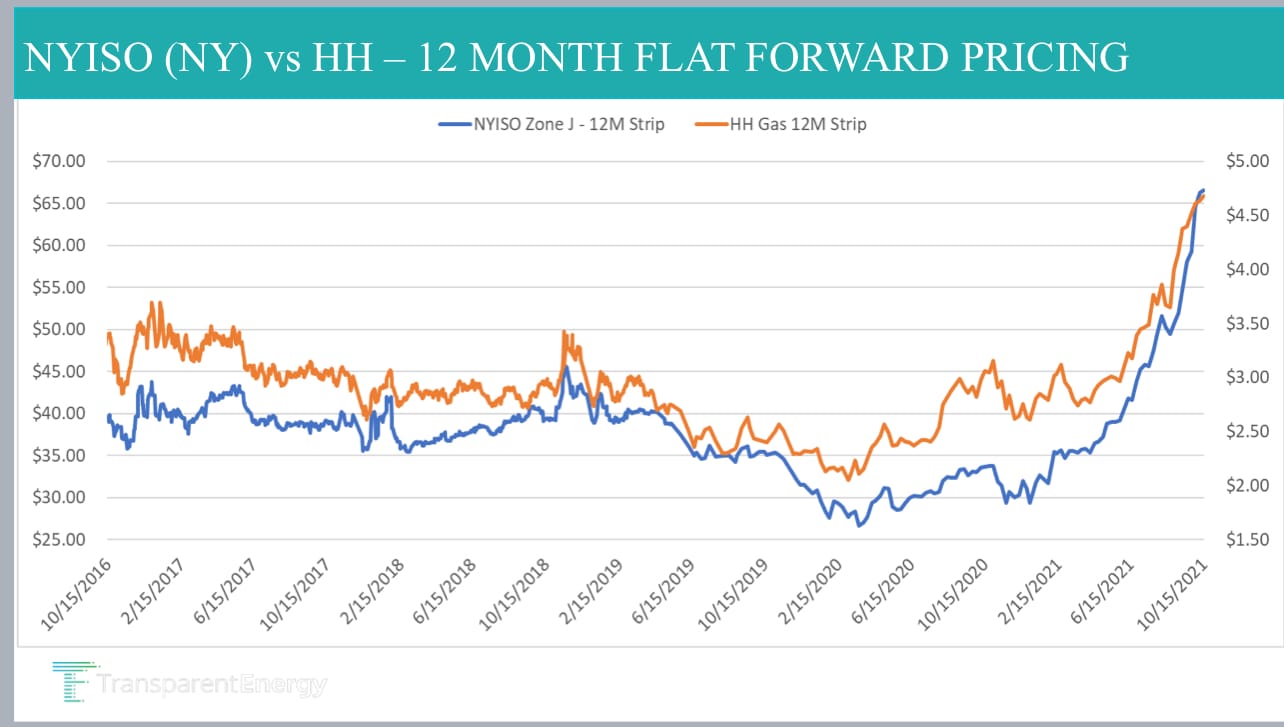
What Sustainable Westchester labels as “Sustainable” energy (and charges you 20-60% more for the goody green feelings that entails, for some) is that exact same Natural Gas and Nuclear fueled electricity delivered by Con Edison or NYSEG but with the added cost of paying for “certificates” sold by the operator of that waterfall-propelled turbine in upstate New York, apparently Eagle Creek Renewable Energy.
Here is a primer on buying and selling these certificates:
When renewable energy is produced, there are actually two components to the generation; the kilowatts of electricity produced and the environmental attributes of the electricity – the “claim” of clean energy. RECs represent the attribute of energy produced from a renewable energy facility.
Sustainable Westchester customers are buying the environmental claim of renewable energy, not the electricity because it is impossible to distinguish which electrons are green and which are not.
Buying RECs does not put more electricity on the grid because RECs are not electricity but a made up number which proponents claim represents something they call the environmental attributes of the electricity.
The Department of Public Services explains this quite well in our Q&A below:
“When a customer buys renewable energy as part of a CCA program, they are not receiving electricity directly from a renewable generating facility due to the physics of the electric grid. Instead, RECs are purchased to offset the customer’s usage. A REC is an environmental attribute associated with one megawatt hour of electricity generated from a renewable energy source. A CCA administrator offering renewable energy will need to purchase RECs to offset the load of the municipality by whatever percentage is offered by the program (100% renewable, 50%, etc.).”
All the environmental attributes of all the electricity in the universe could not power a single 40-watt bulb for one second. It is a term-of-art intended to deceive ratepayers into thinking they are getting electricity from turbines turned by wind, water or solar when they are actually getting the same electricity from turbines turned mostly by Natural Gas and Nuclear.
This made up number is assigned to each kilowatt generated from solar, wind and water. A company like Eagle Creek Renewable Energy sells (directly or through day traders in the REC market) the so-called environmental attributes of their electricity to an ESCO selected by Sustainable Westchester, which is why the so-called green electricity sold by Sustainable Westchester costs more than the standard electricity sold by Sustainable Westchester — the difference is primarily the cost of paying for environmental attributes of electricity not actual electricity.
Economists call this a tax.
Sustainable Westchester is a clever but deceitful way for municipal officials to impose a tax on their residents and businesses to subsidize their preferred electrical generation facilities where the tax does not show up on the municipal property tax bill of residents but gets buried in a number within a number, all hidden in plain sight, tucked inside an inscrutable utility bill few ratepayers understand.
Sustainable Westchester would argue that all their subterfuge is acceptable because it is for the greater good but it still amounts to elected officials deliberately misleading their constituents about their binding them to much higher electric bills without their knowledge or consent.
When your electric bill skyrockets and you call your local representative they can blame someone else and wash their hands of the matter without acknowledging they voted to default all of their constituents to more expensive “green” electricity which is really just electricity from almost entirely Natural Gas and Nuclear with a tax on it.
Sustainable Westchester just sought approval last month from its regulator, the Department of Public Services, to mail out notices to newly-eligible ratepayers in their coverage area: unless they opt-out in the next two weeks, their “green” electricity will cost those poor souls 65% more than their neighbors getting the exact same bad electricity from Con Edison.
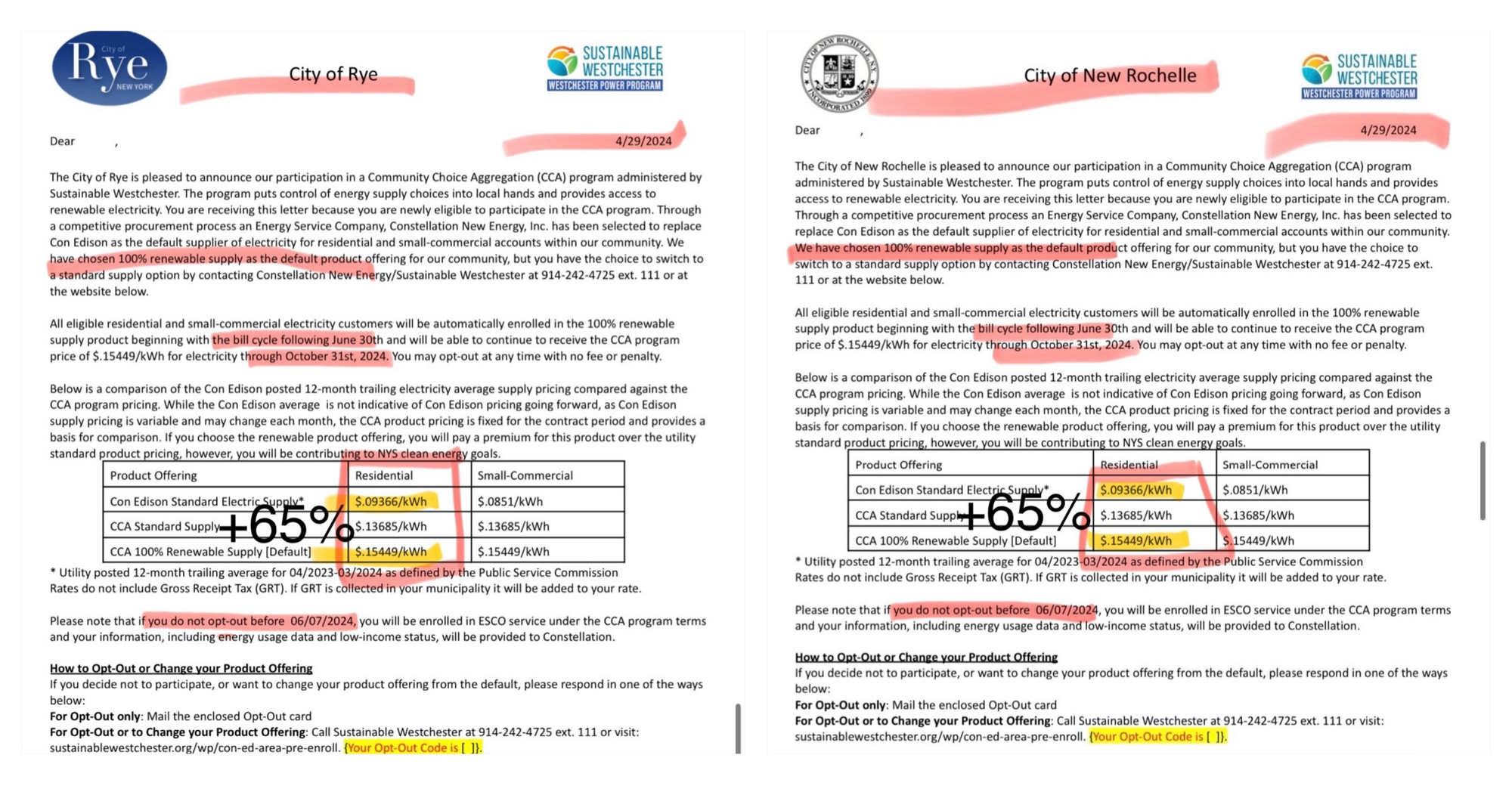
A $200 electric bill for those ratepayers will now cost $330.
For your $330, you will get electricity generated using the exact same fuel mix as your neighbor paying $200 but you will feel morally superior to that neighbor.
Do not feel too smug about that because if you are one of the tens of thousands opted-in to Sustainable Westchester then you have been paying that price difference since 2022.
Sustainable Westchester is a confidence trick designed to lure well-meaning people willing to pay more to get green electricity by letting them believe green electrons from a waterfall are magically pouring out of their wall sockets to power their home while taking everyone else hostage for what they have decided is “the greater good”.
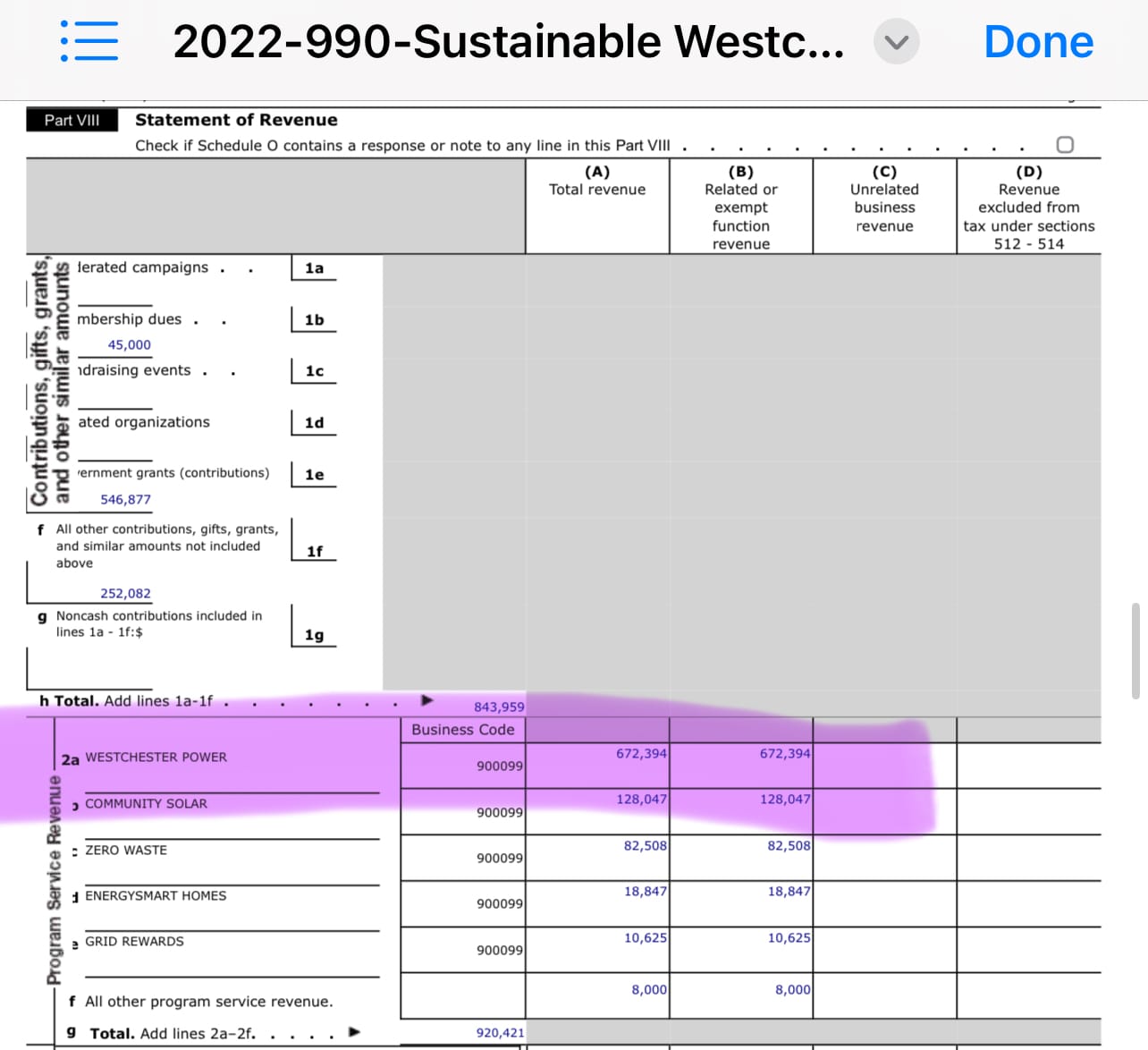
The greater good includes a Program Manager Fee for Sustainable Westchester of $0.00175 for each kWh delivered. According to their 2022 990 IRS Form, that added up to $672,394 in pure profit to pay six figure salaries and bonuses to employees like Noam Bramson and Dan Welsh.
Readers can view the Department of Public Services database and search for “Sustainable Westchester” and see the countywide “newly eligible” cover letters, submitted by Sustainable Westchester on April 23, 2024, for approval by the New York State Department of Public Services.

These letters, paid for by Sustainable Westchester but sent in the name of the various municipalities with their official seal, state:
All eligible residential and small-commercial electricity customers will be automatically enrolled in the 100% renewable supply product beginning with the bill cycle following June 30th and will be able to continue to receive the CCA program price of $.15449/kWh for electricity through October 31st, 2024. You may opt-out at any time with no fee or penalty.
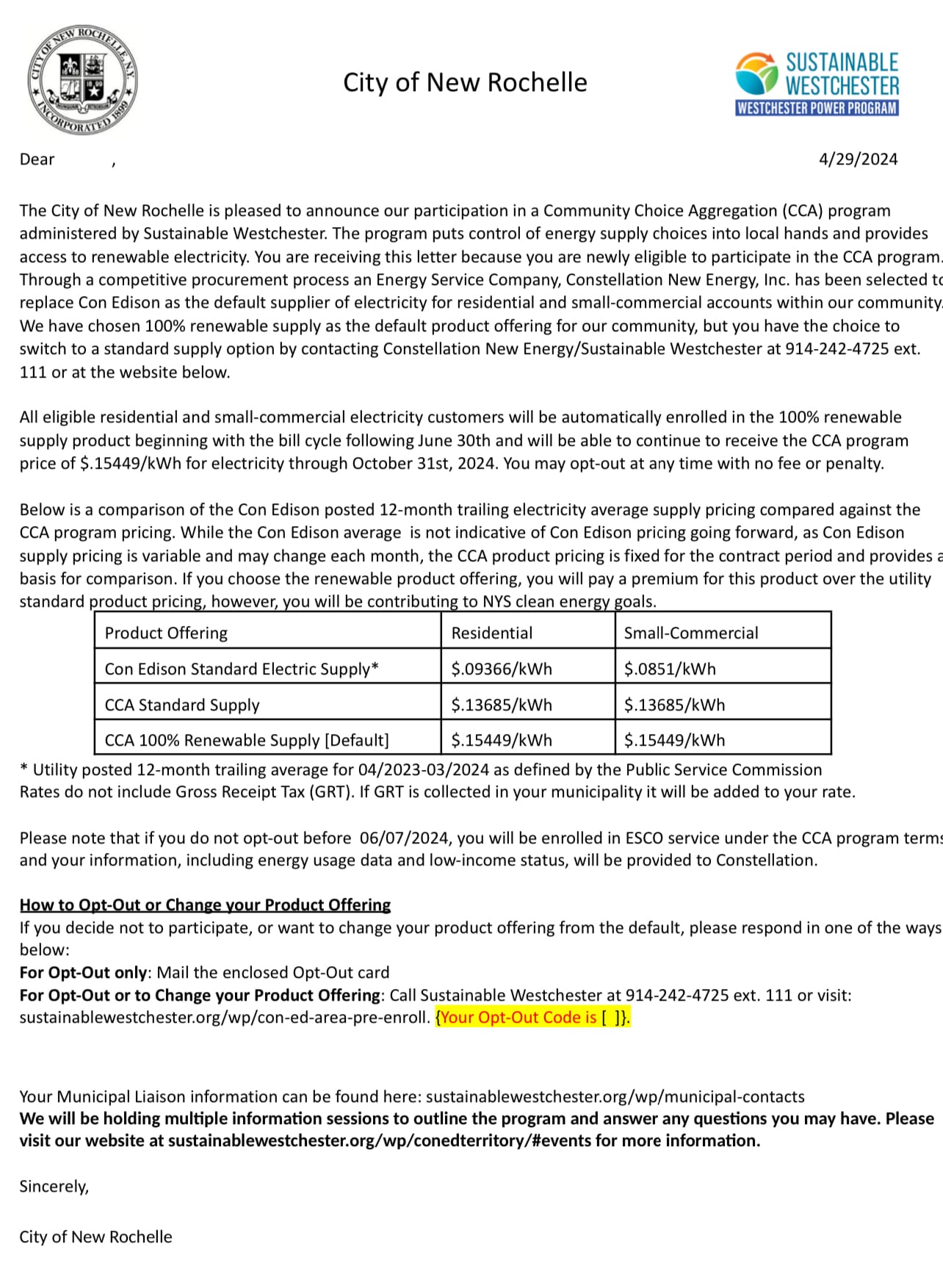
The letter compares the Con Edison posted 12-month trailing electricity average supply pricing for 04/2023-03/2024 to the CCA 100% Renewable Supply pricing.
SEE: Electric customers of Sustainable Westchester pay $48M more with 2-year renewables pact
The gap between the 12-month trailing average pricing for standard Con Edison Residential Supply ($.09366/kWh) and the CCA 100% Renewable Supply ($.15449/kWh) is significant — about 65% higher.
Greenburgh Town Supervisor Paul Feiner helpfully posts monthly comparisons between Con Edison and Sustainable Westchester on the Greenburgh Town website based on prices provided to him by Sustainable Westchester.
The gap between the April 2023 pricing for standard Con Edison Residential Supply ($.1053/kWh) and the CCA 100% Renewable Supply ($.15449/kWh) is likewise significant — as of last month it was about 47%. higher.
According to Con Edison, the average electric bill for residential Con Edison customers in New York in 2023 was around $170 per month, based on an average usage of 600 kWh per month at 24 cents per kWh. About two-thirds of that average bill is delivery charges of about 14-16 cents per kWh ($112) and supply charges of about 8 cents per kWh ($58).
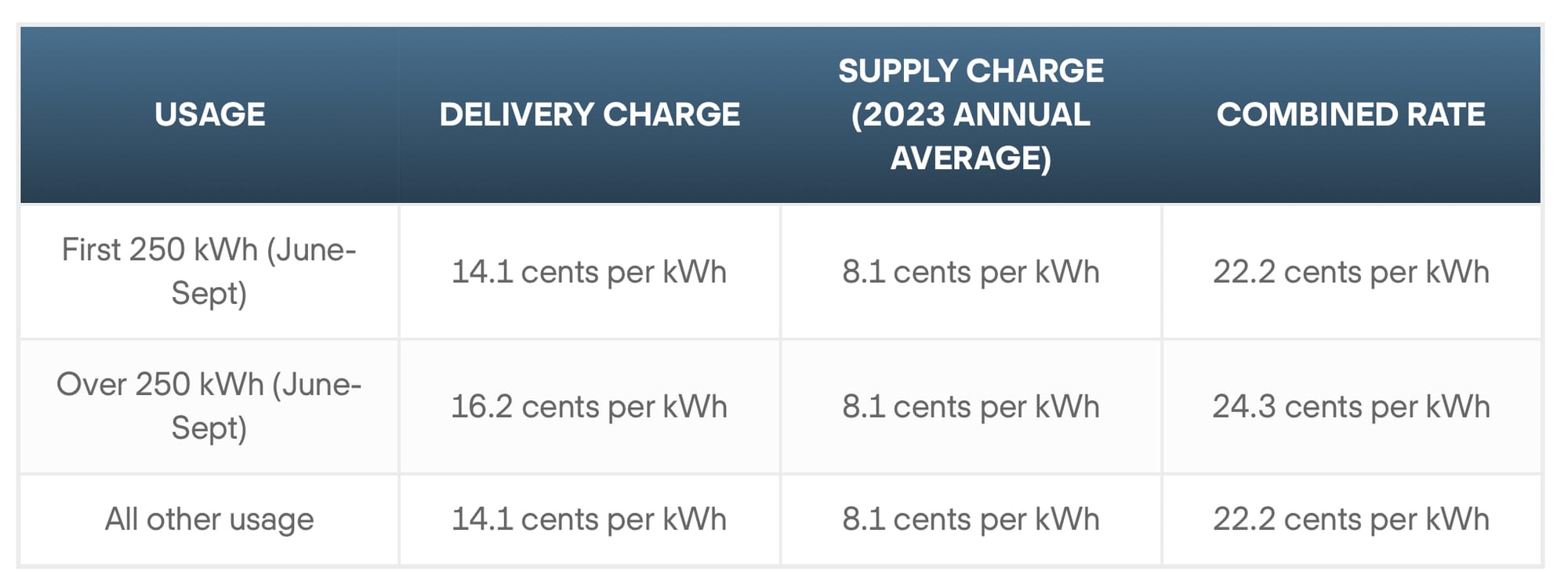
For a customer with the CCA 100% Renewable Supply rate of about 15.5 cents per kWh, the cost of delivery is the same, about $112 per month but the cost of supply is much higher, about $93 per month.
Based on these figures, the average electric bill for residential Con Edison customers in New York who are opted-in to the CCA 100% Renewable Supply rate is around $205 per month including delivery charges, about 21% higher. Excluding delivery charges, just comparing the standard Con Edison rate, the CCA 100% Renewable Supply rate is about 60% higher.
Bottom Line: Newly eligible customers must opt-out of Sustainable Westchester over the next two weeks or their electric bill will jump about 20% based on the trend over the past two years.
Please note that if you do not opt-out before 06/07/2024, you will be enrolled in ESCO service under the CCA program term and your information, including energy usage data and low-income status, will be provided to Constellation (Constellation New Energy, Inc.).
The gap between the April 2023 pricing for standard Con Edison Residential Supply ($.1053/kWh) and the CCA 100% Renewable Supply ($.15449/kWh) is likewise significant — as of last month it was about 47%. higher.
The aggregate amounts of overages run into the tens of millions dollars.
Department of Public Services Q&A
We reached out to DPS to get answers to some of the questions we hear most from readers.
Q. By far the most controversial aspect of the Sustainable Westchester Community Choice Aggregation Program is that the contracts with municipalities are all “opt-out” only. Having now viewed video of quite a few public meetings in New Rochelle, Rye and Lewisboro I have yet to hear a logical explanation for this. Mostly, it is variations of “it makes it better for us”. Is there some requirement that CCA programs be opt-out only? Does this come from DPS? Any thoughts are appreciated.
A. While there is no requirement that a CCA program enroll customers on an opt-out basis, CCA programs were authorized by the Commission in 2016 to be conducted on an opt-out basis because the programs would not gain sufficient economies of scale if conducted on an opt-in basis.
Q. In the period December 2021 to March 2022, the SW CCA program in both Con Ed and NYSEG areas lapsed then was re-started. I viewed an extensive presentation and active Board discussion about this in Lewisboro on November 8, 2021. I saw no such extensive presentation and active discussion in New Rochelle or Rye. I do see a letter dated August 16, 2022 from DPS Director, Markets and Innovation Marco L. Padula to Westchester Power Operations Manager which states “Customers in the Con Edison utility territory (Appendix A) were returned to the utility when the previous supply contract ended on June 30, 2022, which means that Sustainable Westchester must meet the requirements for starting a new program, not the requirements for an active program going through a contract renewal or extension.” How would I be able to confirm that Sustainable Westchester notified Appendix A ratepayers and/or municipalities in their CCA Program at the time that they had been reverted to Con Edison or likewise for Appendix B to NYSEF as of November 30, 2022. I spoke to some municipal officials off the record who had no recollection of what was a rather significant event.
A. The letter from Mr. Padula was in reference to Sustainable Westchester needing to conduct new outreach and education prior to starting a new program after the previous one ended. In relation to your question, customers would have received a notification letter from the ESCO explaining that their supply provider was switched back to the utility due to Sustainable Westchester’s June 30, 2022 contract expiration. Following the receipt of the ESCO notification letter, customers would have received an opt-out letter from Sustainable Westchester with the terms of their new contract. That opt-out letter was sent after SW conducted outreach and education within municipalities located in the Con Edison service territory.
Q. Much is made by Sustainable Westchester during their presentations of “price to exceed”. They talk about a 12 month look back on the regulated utility price of electricity and they use that data to set a “price to exceed” which is put into the MOUs voted on by municipal councils and executed by municipal executives. From what I see this only “works” if electricity prices are relatively stable. In other words, it does not work. In fact, it makes no sense at all. It seems designed to create the illusion that there is some analytical basis for setting the so-called “price to exceed” when it is effectively random.
A. We do not directly regulate CCA pricing practices, other than imposing certain product/pricing restrictions similar to what’s already used for ESCOs in New York State, which includes that fixed-rate standard product offerings be limited to a price no greater than 5% above the trailing 12-month average utility supply rate. Also, variable-rate products must guarantee a savings compared to what the customer would pay as a full-service utility customer. There are no pricing restrictions on renewable energy products, but those products must comply with requirements regarding the sourcing of the renewable energy.
We require Administrators to include the following language on the: “Below is a comparison of the utility posted 12-month trailing (electricity, natural gas, or electricity and natural gas) average supply pricing compared against the CCA program pricing.”
While the utility average is not indicative of utility pricing going forward, as utility supply pricing is variable and may change each month, the CCA supply offering is fixed (we do not currently have a variable price offering) for the contract period and provides a basis for comparison.
Administrators are required to fill in a table with the contract’s offering and rate and compare that CCA offering to the utility posted 12-month trailing average.
Q. Sustainable Westchester likes to describe itself as a consortium of municipalities with what they call “Chief Electeds” sitting on a committee that does things like discuss and approve “price to exceed” levels that go into MOUs and are the basis for accepting bids, future direction of the energy market, policy, approving new board members. They also have a Board of Directors which hires/fires the Executive Director. It is unclear — and not stated publicly that I could find — how any of this works. There are no public meeting minutes or records of votes, no detailed financial records (just 990s and an Annual Report). Does DPS get any information like this from Sustainable Westchester? Can I get it?
A. DPS does not receive this information.
Q. How does electricity generated by, say, a hydroelectric plant in upstate New York relate to the electricity that powers a lamp in Rye. At a public meeting in Rye, a woman asked a question like this — is the electricity powering my lamp all coming from the hydroelectric plant upstate? What is that electricity in my home? How does a REC fit into this? I believe I know but would like an official explanation.
A.When a customer buys renewable energy as part of a CCA program, they are not receiving electricity directly from a renewable generating facility due to the physics of the electric grid. Instead, RECs are purchased to offset the customer’s usage. A REC is an environmental attribute associated with one megawatt hour of electricity generated from a renewable energy source. A CCA administrator offering renewable energy will need to purchase RECs to offset the load of the municipality by whatever percentage is offered by the program (100% renewable, 50%, etc.). Note that the CCA’s renewable product offerings must comply with New York’s Clean Energy Standard’s REC requirements. To be compliant, a REC must either be generated in New York State, or be generated in a neighboring control area, with the REC and energy delivered into New York.
Q. Sustainable Westchester often says during its presentations that a customer can opt-out of Sustainable Westchester at any time with no penalty. The current co-chair, Sara Goddard, a Rye City Council member, said if people wanted they could arbitrage the daily price difference between Sustainable Westchester and Con Edison by opting-out and opting-in and opting-out and opting-in. Given the 2 month delay in opting-out is this possible?
A. DPS Staff is unsure what two-month delay you are referring to, though agrees daily switching would not be possible. Given the timing of bill issuance and billing periods which vary by customer depending on when utility service was first initiated, it may take a full billing period or longer to switch a customer between an ESCO and utility and vice versa. That said, there is no established two-month timeframe for switching customers.
Q. Anecdotally, I have been told that ratepayers who opt-out of SW end up switched back to SW from Con Ed. Also, property managers are playing whack-a-mole by working with tenant to opt them out of SW then finding when an apartment turns over it is switched back to SW from Con Ed. It appears that anytime there is a change to account — a new account number or other — the account reverts to SW. I have never seen an SW presentation that explains how this works and why. Can you provide an explanation?
A. Once a customer opts-out of a CCA program, that decision is preserved for the life of the program and the customer should not be reenrolled in the program. Regarding new customers, when a new customer enters a municipality that has a CCA program, that customer, if eligible, will be included on the next “newly eligible customer” list that is provided by the utility to the CCA administrator upon request for subsequent opt-out enrollment in the program. In practice, CCA administrators generally receive these newly eligible customer lists every few months. These newly eligible customers should receive an opt-out letter similar to those received by the customers initially enrolled.
Q. From time to time, SW presentations will have a slide that shows their fixed rate price compared to the Con Ed or NYSEG variable rate. They do not say the source. Is there an independent source for this data from their launch in May 2016 until today? Is it available by municipality? By residential and commercial? By standard and sustainable? I would a spreadsheet so I can make charts, by municipality if possible.
A. Without seeing the slides in question, Staff is unable to say where Sustainable Westchester was sourcing its data if those slides were presented prior to the Commission’s January 2023 CCA Modification Order. Within that January 2023 order, CCA administrators were required to utilize the 12-month trialing average that utilities post quarterly in case 15-M-0127 and on their individual websites as a price to compare with the CCA contract rate. Generally speaking, historic data on utility rates can be found on the Commission’s and individual utility websites.
NOTE: I replied by sending this slide:
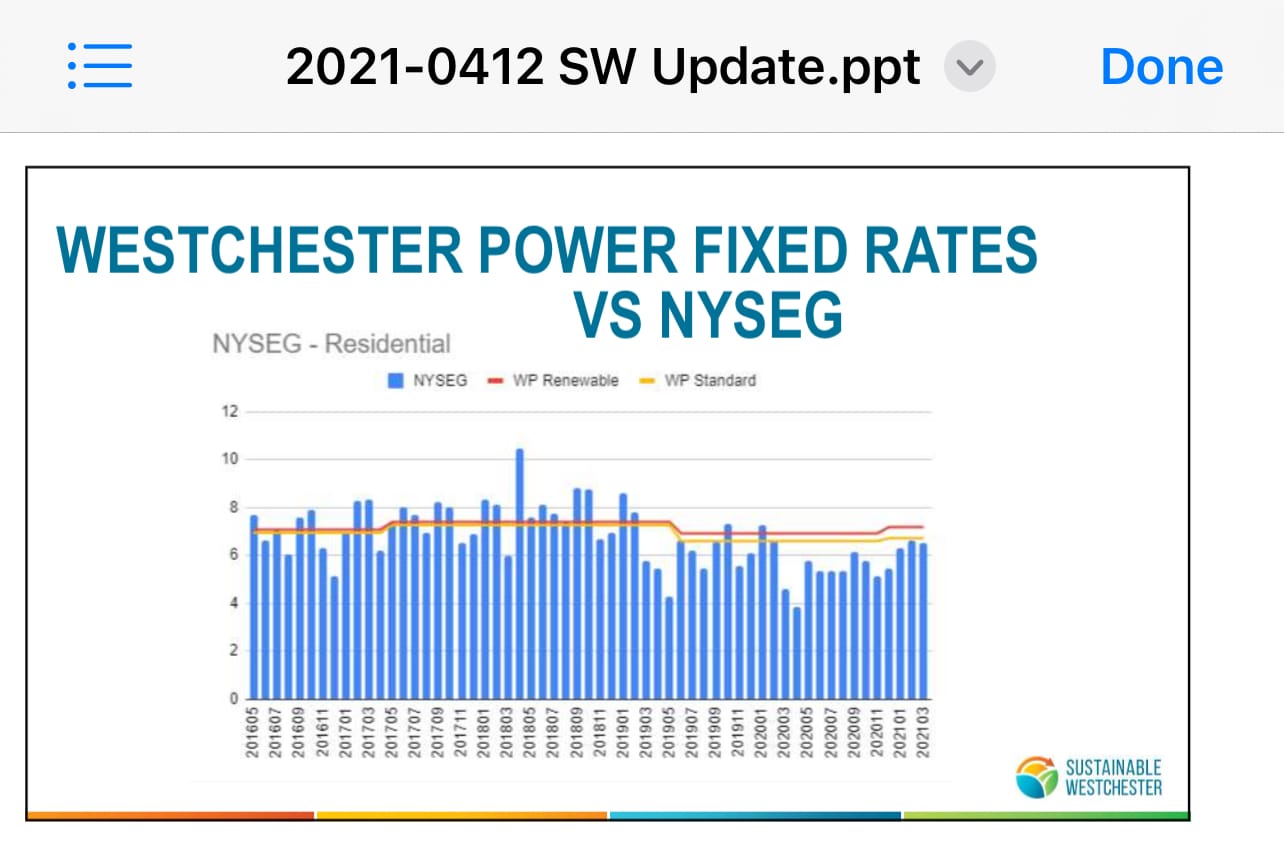
Q. I am told Constellation, the ESOC for Sustainable Westchester, is banned in a number of states including New York. Is that true? If so, can I get a record of that?
A. Constellation is not banned from doing business in New York.
Highlights
- There is no requirement that a CCA program enroll customers on an opt-out basis but they are authorized to do so.
- Once a customer opts-out of a CCA program, that decision is preserved for the life of the program and the customer should not be reenrolled in the program.
How to Opt-Out of Sustainable Westchester — and save big money.
